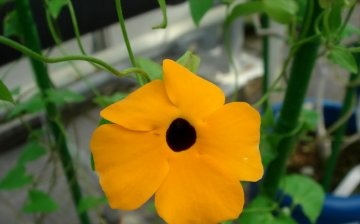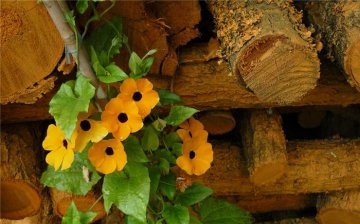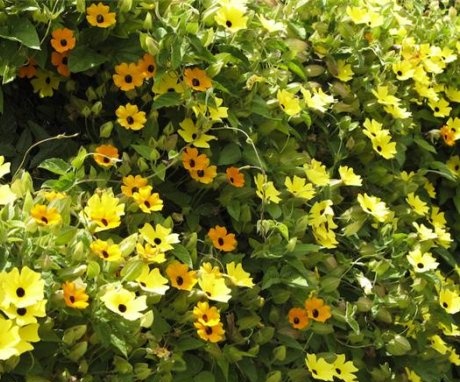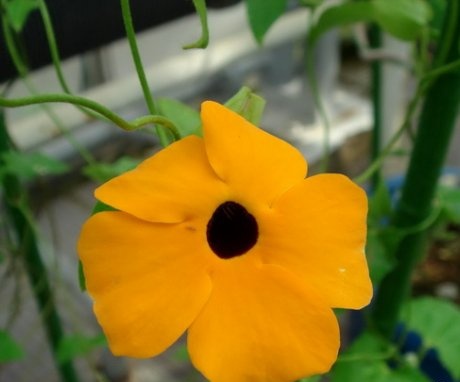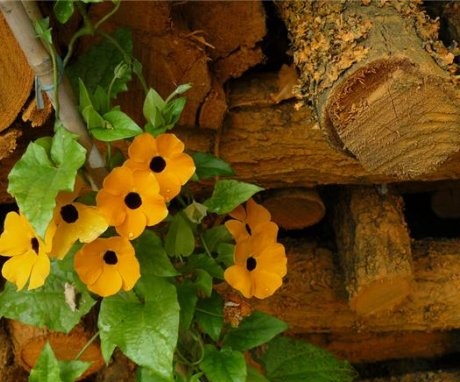Tunbergia from seeds - we grow ourselves
Many growers prefer versatile flowering plants that can be grown not only in the garden, but also to decorate the home interior. Tunbergia is quite suitable for such purposes. This exotic climbing plant blooms from May to late September. It perfectly decorates open balconies, loggias, wide window sills and the foreground of the garden. With its long shoots, it beautifully frames the lattice of the garden gazebo, and the arches entwined with thick green lashes with bright inflorescences look especially impressive.
Content:
- Sowing Tunbergia seeds correctly
- We plant tunbergia seedlings in the ground
- Features of caring for tunbergia
Thunbergia is an annual plant, so lovers of chic decorative flowers should grow it every year, starting all over again. But it's worth it. Flowering tunbergia has many varieties, among which the erect, grandiflora, Mysore, fragrant, winged, large-flowered and other species are very common. All of them differ from each other in size and color of flowers.
Sowing Tunbergia seeds correctly
Most growers grow tunbergia from seed and are quite successful. Many of them argue that this is not at all troublesome, the main thing is that the seeds of the plant are fresh. Collecting seed is not easy. The plant, when ripe, quickly opens its capsules, throwing seeds to the ground.
Tunbergia seeds are sown in late February - early March. Before sowing, you can treat the seed material with a growth accelerator, which is sold in flower shops. In order to achieve friendly germination, you need to sow seeds in special containers and maintain a constant temperature of + 18- + 20 degrees. They should not be buried deep in soil, lightly sprinkle with it.
The crops are well moistened and covered with a transparent film or a plastic bottle, the bottom of which is cut off, and the neck is left without a cork. In such an unpretentious way at home, you can create greenhouse conditions under which the emergence of seedlings is accelerated. If you are constantly engaged in the cultivation of different crops, it is advisable to purchase a mini-greenhouse, it will serve you for many years.
A container of tunbergia seeds is placed on a windowsill near a southwest-facing window. The plant likes sufficient daylight, but is afraid of direct sunlight. If you follow all the conditions, the first tender shoots of tunbergia will appear in a week, which, you see, is quite unexpected.
We plant tunbergia seedlings in the ground
Approximately in mid-May, when the tunbergia seedlings are completely stronger, they can be planted in the ground in a permanent place in the garden. Seedlings are planted, keeping a distance of at least 45 centimeters. Be sure to install trellises, pergolas, young shoots will curl along them, forming a thick green curtain.
The place for tunbergia is chosen well-lit and without draft. The soil should be light, permeable, with the addition of lime and nutrients. You can mix leaf and sod soil, and add some sand, peat, and humus. If you decide to grow tunbergia at home, then every year you need a plant transplantpicking up larger pots each time.
After the plants take root, they quickly grow. When 3-4 strong leaves appear pinch every seedling.This will improve the branching of the plants and promote the fastest flowering. After all, this is what the flower growers are trying to achieve! Approximately 100-110 days after pinching, tunbergia begins to bloom profusely.
Features of caring for tunbergia
Until flowering, tunbergia is watered moderately. When the plant blooms watering increase and continue to moisturize until the end of flowering. It should not be allowed that during the abundant flowering, the earth around the plant dries up - this threatens to fall off the buds. You can spray the leaves more often to ensure the desired humid climate. After the end of flowering, when the plant begins to dormancy, watering is reduced.
In the spring-summer season, especially during the budding period, the tunbergia needs to be fed about once every three weeks. Liquid mineral fertilizers are well suited for this. In winter, feeding is not done, since the plant rests during this period and in feeding does not need.
For the formation of a beautiful and lush form with the beginning of the growing season, you need to constantly cut off weak shoots and pinch young twigs.
Thunbergia is a very delicate plant and is often susceptible to disease. In very dry air, the leaves dry around the edges, and with an excess of moisture, rot spots may appear. Lack of lighting can cause buds to fall off. The plant is easily damaged by scale insects and spider mites. Therefore, proper care of Tunbergia is very important.
During pest infestation, plants are sprayed with fungicides and the damaged leaves must be removed.
Don't be afraid to grow Tunbergia! She will delight with unusual flowering and create a great mood for you.





